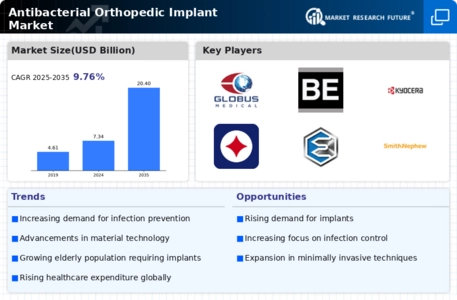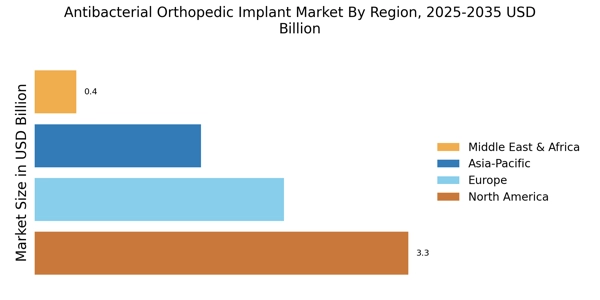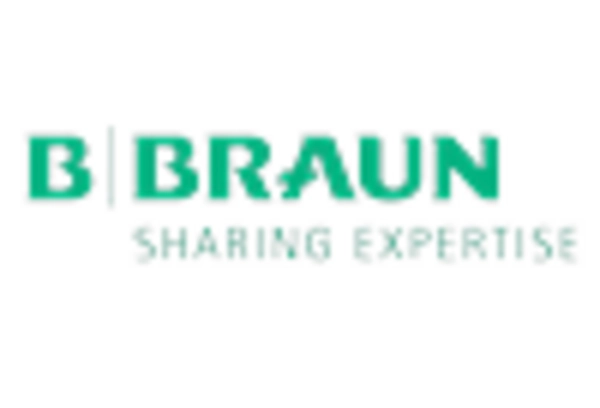Rising Incidence of Orthopedic Surgeries
The Antibacterial Orthopedic Implant Market is significantly influenced by the rising incidence of orthopedic surgeries, driven by an aging population and increasing prevalence of musculoskeletal disorders. According to recent data, the number of orthopedic procedures is projected to grow by approximately 5% annually over the next few years. This increase in surgical interventions necessitates the use of high-quality implants that minimize the risk of infections. As a result, healthcare providers are increasingly opting for antibacterial orthopedic implants, which are perceived to offer enhanced safety and efficacy. The growing awareness among patients regarding the importance of infection control in surgical outcomes further propels the demand for these specialized implants. Consequently, manufacturers are focusing on developing innovative solutions that cater to this expanding market.
Growing Awareness of Postoperative Infections
The Antibacterial Orthopedic Implant Market is experiencing growth due to the increasing awareness of postoperative infections among both healthcare professionals and patients. Educational initiatives and campaigns aimed at highlighting the risks associated with surgical infections have led to a heightened focus on infection prevention strategies. As a result, there is a growing preference for antibacterial orthopedic implants, which are perceived as a proactive measure to mitigate infection risks. Recent surveys indicate that a significant percentage of patients are now inquiring about the antibacterial properties of implants prior to surgery. This shift in patient expectations is prompting healthcare providers to prioritize the use of these specialized implants, thereby driving demand in the market. The emphasis on infection control is likely to continue influencing purchasing decisions in the orthopedic sector.
Regulatory Support for Antibacterial Solutions
The Antibacterial Orthopedic Implant Market is positively impacted by regulatory support for the development and approval of antibacterial solutions. Regulatory bodies are increasingly recognizing the importance of addressing infection control in surgical procedures, leading to streamlined approval processes for innovative antibacterial implants. This supportive regulatory environment encourages manufacturers to invest in research and development, fostering innovation in implant technologies. As a result, a wider range of antibacterial orthopedic implants is expected to enter the market, providing healthcare providers with more options to enhance patient safety. Furthermore, regulatory incentives for the adoption of advanced medical technologies are likely to accelerate the growth of this market segment. The alignment of regulatory frameworks with industry needs suggests a promising future for antibacterial orthopedic implants.
Increased Investment in Healthcare Infrastructure
The Antibacterial Orthopedic Implant Market is benefiting from increased investment in healthcare infrastructure across various regions. Governments and private entities are allocating substantial resources to enhance healthcare facilities, which includes upgrading surgical equipment and implant technologies. This investment is particularly evident in emerging markets, where the demand for advanced medical solutions is on the rise. Enhanced healthcare infrastructure not only facilitates the adoption of antibacterial orthopedic implants but also improves patient access to quality surgical care. As hospitals and clinics strive to meet international standards, the integration of antibacterial solutions into orthopedic procedures becomes a priority. This trend is expected to drive market growth, as healthcare providers seek to reduce infection rates and improve patient outcomes through the use of advanced implant technologies.
Technological Innovations in Antibacterial Coatings
The Antibacterial Orthopedic Implant Market is witnessing a surge in technological innovations, particularly in the development of advanced antibacterial coatings. These coatings are designed to prevent bacterial colonization on implants, thereby reducing the risk of postoperative infections. Recent studies indicate that implants with these coatings can decrease infection rates by up to 50%. As healthcare providers increasingly prioritize patient safety, the demand for implants featuring these innovative coatings is likely to rise. Furthermore, advancements in nanotechnology are enabling the creation of more effective antibacterial agents that can be integrated into implant materials. This trend not only enhances the performance of orthopedic implants but also aligns with the broader movement towards personalized medicine, where tailored solutions are developed to meet individual patient needs.


















Leave a Comment